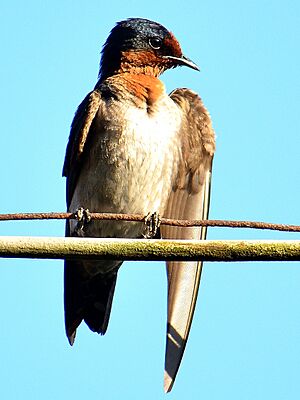Pacific swallow facts for kids
Quick facts for kids Pacific swallow |
|
|---|---|
 |
|
| At Manado, North Sulawesi | |
| Conservation status | |
| Scientific classification | |
| Genus: |
Hirundo
|
| Species: |
tahitica
|
The Pacific swallow (Hirundo tahitica) is a small passerine bird in the swallow family. It breeds in tropical southern Asia and the islands of the south Pacific. It is resident apart from some local seasonal movements. This bird is associated with coasts, but is increasingly spreading to forested uplands. The hill swallow and the welcome swallow were formerly considered conspecific.
Contents
Taxonomy
The Pacific swallow was formally described in 1789 by the German naturalist Johann Friedrich Gmelin in his revised and expanded edition of Carl Linnaeus's Systema Naturae. He placed it with the swallows in the genus Hirundo and coined the binomial name Hirundo tahitica. Gmelin based his entry on the "Otaheite swallow" that had been described and illustrated in 1783 by the English ornithologist John Latham in his book A General Synopsis of Birds.
Seven subspecies are recognised:
- H. t. javanica Sparrman, 1789 – south Myanmar and Andaman Islands to south Vietnam, east to Philippines and south to Moluccas and Greater and Lesser Sunda Islands
- H. t. namiyei (Stejneger, 1887) – Ryukyu Islands (south Japan) and Taiwan
- H. t. frontalis Quoy & Gaimard, 1832 – north, west New Guinea including Raja Ampat Islands (northwest New Guinea), Aru Islands (southwest of New Guinea), Geelvink Bay is. and islands off north coast
- H. t. albescens Schodde & Mason, IJ, 1999 – south, east New Guinea and satellites
- H. t. ambiens Mayr, 1934 – New Britain and satellites (southeast Bismarck Archipelago)
- H. t. subfusca Gould, 1856 – Admiralty Islands, New Ireland and satellites (north Bismarck Archipelago) to Solomon Islands (except Rennell Island and including Temotu), Ouvea (west Loyalty Islands, New Caledonia), and Vanuatu to Fiji and Tonga (west, central Micronesia)
- H. t. tahitica Gmelin, JF, 1789 – Mo'orea and Tahiti (southeast Society Islands, east Polynesia)
Description
This species is a small swallow at 13 cm (5.1 in) in length. It has a blue-black back and crown with browner wings and tail, a red face and throat, and dusky underparts. It differs from the barn swallow and the closely related welcome swallow in its shorter and less forked tail.
Behaviour
The Pacific swallow builds a neat cup-shaped nest, constructed with mud pellets collected in the beak, under a cliff ledge or on man-made structures such as a building, bridge or tunnel. The nest is lined with softer material, and the clutch is two to three eggs. It is similar in behaviour to other aerial insectivores, such as other swallows and the unrelated swifts. It is a fast flyer and feeds on insects, especially flies, while airborne.
Gallery







